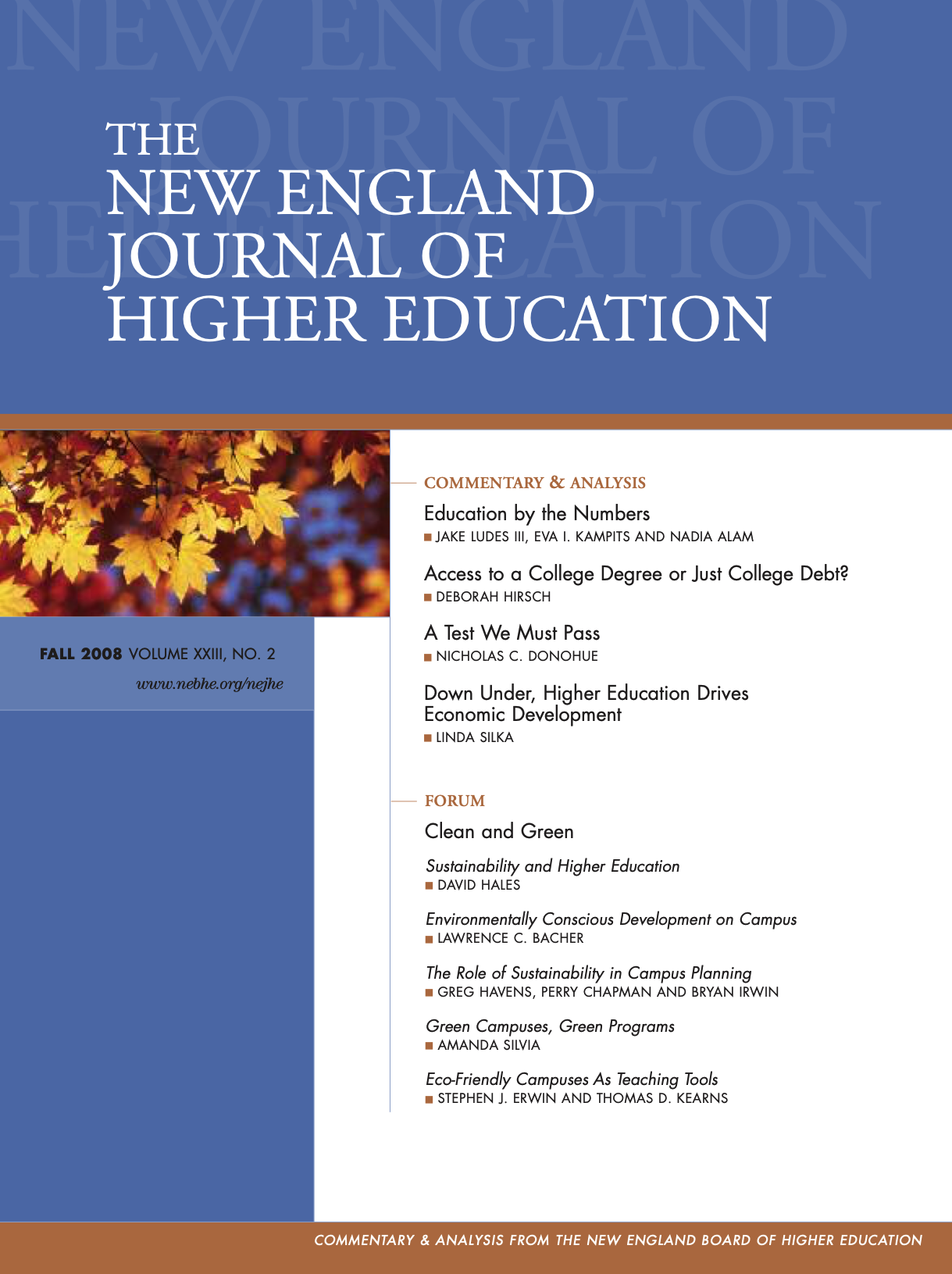
Click the cover image to view and download this issue in PDF format.
BOSTON—New England’s colleges are increasingly “clean and green,” according to a forum in the Fall 2008 issue of The New England Journal of Higher Education (NEJHE).
The Fall 2008 issue, published this week, features a forum with articles examining today’s efforts in New England higher education toward sustainability and preparing for a “green economy.”
The issue also explores education’s economic impact on New England and innovative ways to measure higher education success and community engagement.
The Fall 2008 issue’s forum on sustainability includes the following articles:
Sustainability and Higher Education · We face four fundamental moral imperatives, according to College of the Atlantic President David Hales: alleviating poverty, removing the gap between rich and poor, controlling the use of violence for political ends and changing our patterns of production and consumption to achieve sustainability. “Higher education,” Hales writes, “must move beyond the responsibility to prepare students to live in the world as it will be – we must embrace the responsibility to prepare students to shape the world in which they will live.”
Environmentally Conscious Development on Campus · Justifying expenditures for sustainable development in a difficult economic environment is challenging, writes Lawrence C. Bacher, vice president of higher education at the Providence-based Gilbane Building Co. Nevertheless, Bacher notes, a strong economic and community-relations rationale argues for reducing carbon footprint, using permeable pavement and other high-tech surfaces to drain rainwater, cutting energy use and otherwise pursuing sustainable goals.
The Role Of Sustainability in Campus Planning · Noted architects Greg Havens, Perry Chapman and Bryan Irwin of Sasaki Associates present the University of Maine as an example of how today’s land-grant universities can do for environmental topics what their predecessors did for agriculture and mechanical arts.
Green Campuses, Green Programs · NEJHE editorial assistant Amanda Silvia offers a rundown of some clean and green efforts at New England campuses.
Eco-Friendly Campuses as Teaching Tools · Clean and green also means a competitive edge with environment-minded prospective students. “By taking a strategic approach to student engagement in an institution’s sustainable design and operation decisions and practices, campuses can turn their socially responsible policies into competitive advantage,” write Stephen J. Erwin and Thomas D. Kearns of the Boston architecture firm, Shepley Bulfinch Richardson & Abbott.
Among other articles in the Fall 2008 NEJHE:
Education by the Numbers · New England Association of Schools and Colleges indicates that together, New England’s accredited colleges, universities and schools represent a powerful economic stimulus, with an annual direct economic impact exceeding $99 billion, according to NEASC executive director Jake Ludes III and his NEASC colleagues Eva I. Kampits and Nadia Alam.
Access to a College Degree or Just College Debt? · Access programs and initiatives largely concentrate on preparing students to apply to and enroll in college. Deborah Hirsch, associate vice president for academic affairs at Mount Ida College and former director of the New England Resource Center for Higher Education, warns that unless we ensure that students succeed and persist to graduation, they may well be introduced to a mountain of debt rather than a sea of opportunity.
A Test We Must Pass · We must recognize that knowledge is obtained in various ways and begin to measure competency accordingly. Nellie Mae Education Foundation President and CEO Nicholas C. Donohue explains how multiple forms of assessment may bridge the treacherous gap between high school and college.
Down Under, Higher Education Drives Economic Development · Could fresh new answers to New England’s economic challenges be found half a world away? Linda Silka, professor in the University of Massachusetts Lowell department of Regional Economic and Social Development and director of the university’s Center for Family, Work and Community, explains how we may be able to address these challenges by examining Australian college and university forays into community engagement.
Student Loan Availability: Disaster Averted, but Worries Remain · A New England Board of Higher Education and New England Council survey of college administrators found few major concerns about the availability of federal loans for students and parents for fall 2008. The survey suggested that instances in which students were not able to attend college due to inadequate loan availability were exceptions. The survey did, however, find large increases in the volume of unsubsidized Stafford loans, a greater number of students taking advantage of the $2,000 increase in borrowing limits for unsubsidized loans and a distinct increase in applications for parental PLUS loans. All of this compensates for the contraction in the availability of private/alternative loans. In addition, campus officials cited delays in processing the loans and voiced uncertainty about the availability of funds in 2009. NEBHE President Michael K. Thomas recounts the findings of the survey and warns of futures chills in a new lending climate.
Community Colleges Going Green · “One might suppose that only institutions with flush endowments and overflowing construction budgets can incorporate sustainability into their mission and turn a commitment to the environment into action. Nothing could be further from the truth,” writes Massachusetts state Sen. Joan Menard. NEBHE’s chair tells the story of New England higher education, particularly the region’s community colleges, going green.
Earth Day, Every Day · Acting NEJHE editor John Brady explains how colleges and universities are taking environmental awareness as a daily practice, not merely an idea. They are taking steps, both small and large, toward creating a greener planet.
[ssba]
